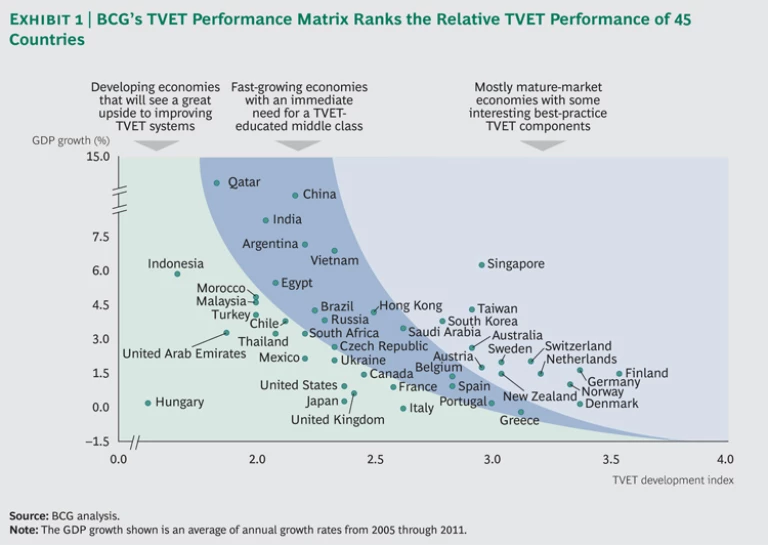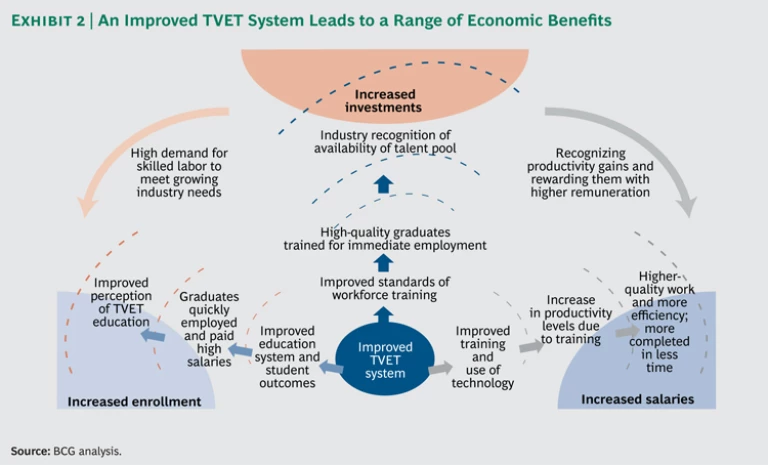Many countries face significant skills gaps across a range of industries, particularly in technical and specialized fields. These gaps persist despite distressingly high unemployment rates even in developed economies. Jobs remain unfilled even as potential workers, lacking the skills and training that industries require, sit idle.
Technical and vocational education and training (TVET) has the potential to address both challenges: closing skills gaps and reducing unemployment. However, TVET suffers from the perception that it is inferior to the general academic education (GAE) provided by traditional four-year universities. In most countries, students, parents, and career advisors still hold a strong bias in favor of degrees from traditional universities and see TVET programs as a “second tier” option that is suited for students with lower aspirations or lesser academic abilities.
The result is a negative-feedback loop: TVET schools are perceived as lower quality, which in turn limits investment in them. With insufficient investment, TVET schools increasingly suffer from inferior infrastructure relative to traditional education channels and have less money for teacher training, curriculum upgrades, and the equipment needed for students to learn the required skills. In 2008, Organisation for Economic Co-operation and Development countries spent an average of just 0.2 percent of their gross domestic product on TVET, compared with 4.3 percent of GDP on early-childhood, primary, and secondary education and 1.3 percent of GDP on traditional tertiary education. The investment shortfall leads to declining outcomes among graduates and reinforces perceptions that TVET is a lesser substitute for GAE.
A related issue is that TVET programs often lack regulatory oversight. Many countries either lack accreditation bodies or have multiple agencies that operate independently. The absence of a single national authority with a complete overview of the entire TVET landscape often leads to different, competing, or confusing standards within a single country. Without consistent regulation, TVET providers have wide latitude to craft their own content, which may lead to significant variations in quality. As a result, employers often do not know what TVET programs are teaching and cannot rely on a consistent pipeline of quality graduates. In some cases, employers have had to retrain their new hires in the skills needed for specific jobs.
Countries can reverse the negative-feedback loop by upgrading TVET schools and ensuring the relevance of TVET to employers. Such steps can generate real value for national economies by putting people to work productively. To make this happen, all stakeholders in national education systems —governments, industry players, TVET providers, and students—will need to collaborate and work to adopt best practices.
Four Key Success Factors
The Boston Consulting Group’s in-depth research on education in markets around the world has revealed four factors that are key to the success of TVET systems:
- The presence of a coordinated ecosystem in which all stakeholders, including a central agency with clear oversight of the TVET ecosystem, actively cooperate
Performance-based government funding and support
- Parity between GAE and TVET and a straightforward means for students to transition between the two tracks
- Sustained, collaborative efforts from industry
A Coordinated Ecosystem. All stakeholders must align their interests and work together to ensure that the TVET ecosystem represents the interests of all participants. This includes having an oversight body that works with stakeholders to determine the long-term strategic direction of the TVET sector and to establish a means of accrediting TVET programs to increase the attractiveness and credibility of TVET for both students and potential employers.
For example, Germany has a clear framework for TVET accreditation and quality control, with input from all key stakeholders. The country’s accreditation council consists of nine members: representatives of government, trade unions, industry, and TVET providers along with independent scientific experts. This council makes recommendations regarding accreditation to the Federal Ministry of Labour and Social Affairs, which sets the regulatory standards that TVET providers must meet.
To receive public funding, TVET providers in Germany must demonstrate that they have sufficient capacity to support their trainees and an efficient system for curriculum development and quality assurance. Teachers and trainers must participate in ongoing training to ensure that they remain current with industry practices and requirements. In addition, TVET providers must get individual training courses certified by an agency; in making its determination, the agency will consider the training requirements for target groups, current employment prospects in specific industries, and defined curricula that include practical work experience.
Performance-Based Government Funding and Support. Although collaboration among stakeholders is crucial, these stakeholders do not have equal influence: the role of government is paramount to drive TVET efforts, primarily by ensuring that such programs have adequate funding. BCG believes that incentive-based funding is an effective tool to drive the quality of TVET schools. These incentives should link to a set of key performance indicators that all stakeholders agree on. TVET schools that tailor student outcomes to industry needs—as evidenced by a strong graduate-employment rate—should be rewarded with greater funding to expand their programs.
In Denmark, the government allocates funding to TVET programs to cover basic costs such as teacher salaries, buildings, and maintenance. However, it also funds TVET using a flexible, “taxi meter” system that links grant amounts to the number of full-time students in a specific program. This incentivizes schools to align supply and demand, drop unpopular programs, and continually seek ways to increase the efficiency of their operations.
Parity and Mobility Between GAE and TVET. In part, students’ negative perception of TVET stems from the current practice of separating TVET into a distinct education “stream,” to which students who fail to meet GAE standards are sent, with no option to return. Changing this perception and increasing student interest in TVET requires increasing the horizontal and vertical mobility between the two paths. Credit transfers between TVET and GAE would attract more and higher-quality students to TVET programs. These programs could also offer postgraduation training to let both TVET and GAE students gain new skills after a period of time in the workforce.
For example, Singapore’s secondary education system is extremely flexible. It offers multiple interconnected paths that allow students to transfer to and from TVET and GAE at any point, not only at the secondary level but also at postsecondary levels.
Sustained Industry Support. Finally, industry can play a critical role in developing the TVET ecosystem. Given their need for highly skilled graduates, industry players can provide input on their requirements for TVET graduates, including specific skills and the labor-demand needs in the short and long terms. Industry representatives can collaborate with TVET providers to develop curricula and—in more direct, one-on-one relationships—offer funding for specific training. Apprenticeships would also offer real-world experience to students and increase the probability of employment upon graduation.
In Germany, for example, industry players have a close working relationship with TVET systems and even fund the majority of their costs. Of the €40 billion in total TVET investment, only one-third comes from the government; it is a mix of spending at the national, regional, and municipal levels, and it covers teacher salaries, infrastructure, and equipment. The remainder comes from private-sector funding, primarily through internal company training in which student-trainees enrolled in TVET programs work and study directly with individual companies. The result is a blend of theoretical and practical learning, funded by public and private sources.
Ranking TVET Systems Worldwide
We looked at TVET systems in 45 markets around the world and ranked their performance on the basis of the four criteria identified above. We assigned countries scores ranging from zero to four for each criterion, with zero representing the lowest score and four the highest.
Because education systems are strongly correlated with the level of economic development within a given country, we plotted the countries’ TVET performance against GDP growth over the past six years. (See Exhibit 1.) This broke our universe of 45 countries into three clear bands:
- Mature economies with strong TVET ecosystems
- Fast-growing economies that are developing their TVET ecosystems and stand to benefit from a more stable set of practices
- Developing economies that have the greatest relative potential gains from making improvements to their TVET ecosystems
Many countries have recognized the benefits of improving their TVET ecosystems and have taken active steps in this direction. For instance, Indonesia, which has one of the fastest rates of economic growth worldwide—and appears to have been relatively resilient in the face of the economic crisis—has implemented several measures to standardize its TVET system. The country’s Ministry of Manpower and Transmigration, which establishes the National Competence Standards for Work, collaborates with private-sector players to identify the key skills required of workers and establish industry-specific standards. Indonesia’s National Education Standards Agency coordinates among stakeholders and develops a framework for competence-based certification based on the National Competence Standards for Work. Finally, a national training system encourages training in the workplace and has established regulations for apprenticeships.
A good TVET system would trigger a ripple effect in the national economy. First, it would improve the perception of TVET and, correspondingly, increase the employability of—and demand for—TVET graduates. This would increase the enrollment in TVET schools. Next, the availability of high-quality, skilled workers would increase investment in the economy by both industry and government. Finally, the increased skill levels would enhance productivity, competitiveness, and efficiency, resulting in positive returns for employers and increased salaries for employees. (See Exhibit 2.)
In conclusion, although TVET is not a panacea for all economic ills, steps to improve national TVET systems can yield clear benefits. Countries that improve their TVET offerings can help close the skills gap and meet the labor demands of private-sector employers, reduce unemployment, and increase national productivity and competitiveness. These gains are primarily economic in nature, but they also have positive multiplier effects for societies, such as keeping students in school, helping alleviate poverty, and fostering lifelong learning among citizens. The process of refining and upgrading TVET requires work—but the rewards will justify the effort.








